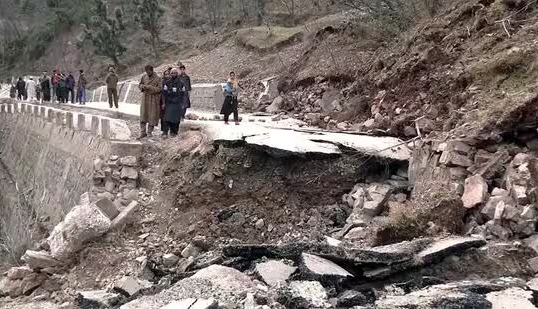Recently, Parnote village of Ramban witnessed a major landslide and land subsidence in which almost 60 houses got damaged and there was a huge loss to the crops; while writing this article I saw some footage were a rivulet in Ramban was flowing with huge boulders and fully loaded with sediments. There were reports of landslides in Uri area as well. The landslides occurred few years back in Budgam area as well which also resulted in loss of property and human lives. The eruption of landslides and land subsidence is not only devastating in terms loss of property and human lives but also pose threat to biological diversity. Every year in the mountain regions of Himalaya, landslides damages many houses and cause loss of millions of rupees by damaging infrastructure, agricultural land and crops etc.
In mountainous areas like Kashmir Himalaya the main cause of landslides and land subsidence is ruthless deforestation, the digging of our terraced tablelands (Karewas) for construction of railways and other roads – a necessary evil, construction of buildings in the anterior of forests, overgrazing, cutting and excavation of slopes are the main causes of landslidesand land subsidence. The construction web of huge roads and railway in this small valley which is very fragile will prove deleterious for the ecology of the beautiful valley. The unplanned development in mountainous areas of Himalaya should be stopped as early as possible. The lessons should be learnt from the recent devastation of Dubai and devastation in Afghanistan where some villages got buried under the debris of landslides. What we built in a decade gets damaged in few days if the planning is not well perceived and ecofriendly. Therefore in future we should be very careful before undertaking such projects for execution.
The landslides usually occur during rainy seasons as the water is commonly the primary factor triggering landslides. Slides often occur following intense rainfall, when storm water runoff saturates soils on steep slopes or when infiltration causes a rapid rise in groundwater levels.The runoff in such areas is fully loaded with sediment, debris; pebbles etc. have higher cutting power than clear water, and the loaded water cause huge devastation. The heavy loaded sedimented water is the main cause of decreasing the depth of rivers, streams, channels and other water bodies, which is also the main reason that water cross the danger level so rapidly in most of the rivers and rivulets and take the shape of flash floods and cause landslides.
The areas where the slopes are nude-without vegetation due to cutting and excavation of slopes and the cutting down of trees in the forests at alarming rate are prone to land sliding and land subsidence. The roots of the plants reduce the occurrence of shallow, rapidly moving landslides by strengthening soil layers and improving drainage. In shallow soils, roots penetrate the entire soil depth, providing anchorages into more stable layers while dense lateral roots stabilize soil surface layers against landslides. Additionally, trees can play a role in slowing and blocking smaller debris flows and rock falls by forming a physical barrier. The trees and plants to some extent also help to retain the rain water and before falling on ground evaporate.
Keeping in view the importance of trees and forests for prevention of landslides, the maintenance of forest/vegetation cover is very much important. It is the need of the hour to replenish the degraded forests of Kashmir by planting the appropriate plant species, avoid cutting and excavation of slopes, digging of our terraced tablelands. The existence of valley largely depends on the green cover and glaciated mountains. These two environmental components i.e. trees and precipitation are closely interlinked with each other. Nationally, the goal is to have at least two-thirds of the total land area in the hills and mountainous regions under forest and tree cover.
In Kashmir valley and Jammu region, forests account for 47% of the geographical area. Therefore, the goal of maintaining adequate forest cover will be achieved in various regions of the J&K by planting appropriate and sizable number of plants in due course of time, the nude slopes can made lush green by planting the native plant species like Ajugabracteosa, Tussilagofarfara, Astragalusgrahaminus, Thymus sp. Primula sp., Clematis sp.etc, so that we will cater the natural catastrophes by natural ways.
(The Author is associated with Department of Botany, University of Kashmir, North Campus. Feedback: [email protected])








